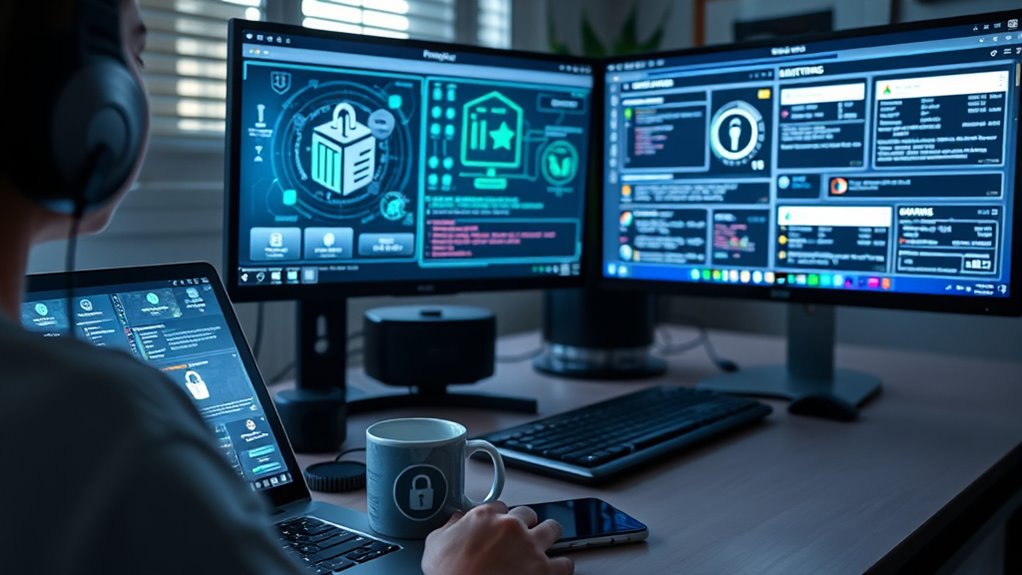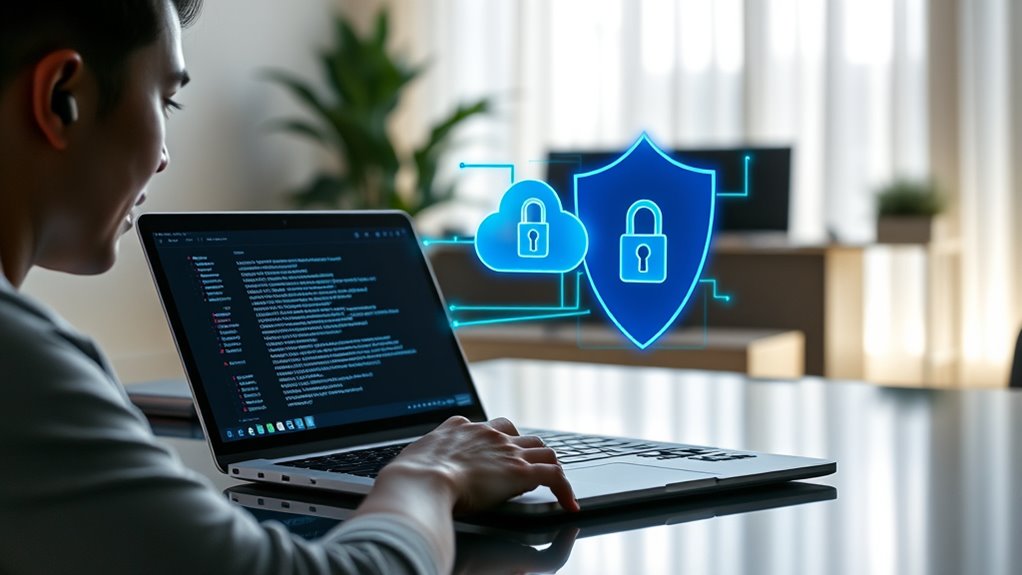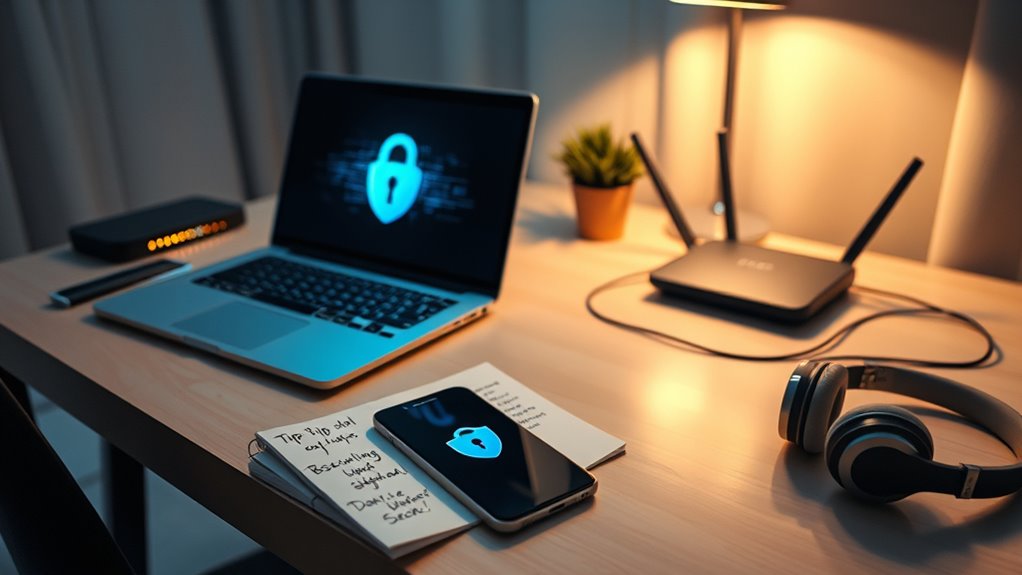In remote work, you’re facing increased cyber risks like data breaches, phishing, and ransomware. Protect your data by using strong passwords, multi-factor authentication, and encrypted connections such as VPNs. Regularly update your devices and software, and stay aware of threats through ongoing cybersecurity training. Utilizing advanced tools like AI-driven threat detection and adopting a zero-trust approach further boosts security. Keep engaged, and you’ll discover more ways to strengthen your remote security defenses.
Key Takeaways
- Use VPNs, multi-factor authentication, and encrypted communication tools to secure data in transit and prevent unauthorized access.
- Keep all devices and software updated with the latest patches to close security vulnerabilities.
- Conduct regular employee cybersecurity training to enhance awareness of phishing, unsecured networks, and best practices.
- Implement zero-trust frameworks with continuous monitoring and micro-segmentation to verify every user and device.
- Enforce strict access controls, regularly audit permissions, and utilize advanced threat detection tools for proactive security.
The Growing Threat Landscape in Remote Work Environments

Have you noticed how remote work has expanded the attack surface for cybercriminals? With employees accessing company systems from various locations and devices, your organization becomes more vulnerable. Cybercriminals target remote infrastructure like home routers and VPNs, knowing they’re often less secure. Endpoint vulnerabilities from personal devices are exploited in nearly a third of ransomware infections, increasing your organization’s risk. Each month, your team faces around 1,000 attempted remote cyberattacks, many of which aim to steal credentials or breach data. Unauthorized access via remote desktop protocols and cloud misconfigurations further expose sensitive information. As your organization adopts remote work, understanding these evolving threats is vital to strengthening defenses and preventing costly breaches. AI security technologies can analyze patterns and detect anomalies in remote access activities, helping to identify potential threats early.
Common Cybersecurity Incidents Targeting Remote Teams

Remote teams are increasingly vulnerable to specific cybersecurity incidents, with phishing emails leading the way as the most common initial breach method. These scams trick you into revealing sensitive data or clicking malicious links, often with convincing messages impersonating colleagues or trusted entities.
Here are the top incidents to watch for:
- Phishing attacks that exploit trust to steal credentials or deploy malware.
- Unpatched personal devices that hackers target through endpoint vulnerabilities.
- Misconfigured VPNs and remote desktop protocols (RDP), which can expose your network to unauthorized access.
- Many organizations are now turning to vetted security solutions to strengthen their defenses against these threats.
These incidents highlight the importance of vigilance and proper security practices. Being aware of these risks helps you recognize threats early and avoid falling victim to cybercriminals targeting remote teams.
Essential Security Measures for Remote Access and Data Protection

Ensuring secure remote access and protecting sensitive data require implementing a combination of effective security measures. First, use VPNs to encrypt data traffic and prevent eavesdropping. Enable multi-factor authentication (MFA) to add an extra layer of security beyond passwords. Keep all devices and software updated with the latest patches to close vulnerabilities. Regularly audit access permissions to guarantee employees only have what they need. Employ encrypted password managers to store credentials securely. Restrict remote desktop protocol (RDP) access and monitor it closely for unauthorized activity. Incorporate endpoint protection solutions that detect and respond to threats in real time. Finally, provide ongoing cybersecurity training to raise awareness of common threats and best practices for data protection. Additionally, organizations can benefit from participating in internal company hackathons to foster innovative security solutions and improve overall cybersecurity resilience.
Overcoming Challenges and Risks in Distributed Workforces

You need to address the security risks posed by personal devices, which many remote employees use for work. Enhancing employee training is essential to improve awareness and reduce vulnerabilities. By focusing on these areas, you can better protect your distributed workforce from cyber threats. Incorporating security awareness programs can further empower employees to recognize and prevent potential breaches.
Securing Personal Devices
Securing personal devices has become a critical challenge for organizations managing distributed workforces, as nearly three-quarters of remote employees use their own devices for work tasks. Without proper safeguards, these devices become prime targets for cyberattacks and data breaches. To protect your organization, consider these steps:
- Enforce strong password policies and multi-factor authentication to prevent unauthorized access.
- Implement device encryption and remote wipe capabilities to safeguard data if devices are lost or stolen.
- Require regular security updates and patches to close vulnerabilities and defend against malware.
Enhancing Employee Training
Effective employee training is essential for strengthening your organization’s cybersecurity defenses in a remote work environment. You need to guarantee your team understands the risks posed by personal devices, unsecured networks, and phishing schemes. Regular, targeted training sessions help employees recognize threats and respond appropriately. Incorporate real-world scenarios and simulate attacks like phishing to reinforce learning. Emphasize the importance of strong passwords, multi-factor authentication, and secure VPN usage. Keep training updated to reflect emerging threats, such as AI-driven social engineering. Make cybersecurity a continuous conversation rather than a one-time event. By fostering awareness and accountability, you reduce risky behaviors and improve your organization’s overall security posture, even as your workforce remains dispersed. Additionally, integrating knowledge about projector technology can be analogous in understanding how crucial clear visualization and accurate data presentation are for effective cybersecurity training sessions.
Emerging Technologies Enhancing Remote Security Postures

AI-driven threat detection tools are becoming essential for identifying and responding to cyberattacks quickly, especially in remote environments. Zero-trust frameworks are gaining traction because they limit access and verify users to prevent unauthorized breaches. Together, these technologies strengthen your organization’s security posture and reduce vulnerabilities in distributed workforces. Implementing regular security assessments can further enhance your defenses by identifying potential weaknesses before they are exploited.
AI-Driven Threat Detection
How can organizations stay ahead of evolving cyber threats in remote work environments? AI-driven threat detection offers a powerful solution. It analyzes vast amounts of data in real-time, identifying anomalies and potential breaches faster than manual methods. Here are three ways AI enhances your security posture:
- Automated Threat Identification: AI quickly detects unusual behaviors, flagging potential cyberattacks before they escalate.
- Predictive Vulnerability Scanning: AI forecasts weaknesses by analyzing patterns, allowing preemptive defenses.
- Adaptive Response Capabilities: AI systems automatically respond to threats, isolating affected devices and minimizing damage.
- Incorporating AI Security Measures is critical to maintaining robust protection in the evolving digital landscape.
Zero-Trust Frameworks
As remote work environments become more complex and distributed, organizations are turning to zero-trust frameworks to strengthen their security posture. You’ll find that zero-trust models require verifying every user and device before granting access, regardless of location. This approach minimizes trust assumptions, reducing vulnerabilities from compromised credentials or untrusted devices. You should implement continuous authentication, micro-segmentation, and strict access controls to limit lateral movement within your network. Zero-trust also emphasizes real-time monitoring and threat detection, helping you identify suspicious activity quickly. Additionally, integrating sound design techniques such as auditory alerts can enhance situational awareness and improve incident response times. By adopting this framework, you ensure that even remote employees accessing data from personal devices or unsecured networks face minimal risk. Zero-trust frameworks are essential in today’s remote landscape, providing a proactive defense against evolving cyber threats.
Addressing Workforce Skills Gaps for Better Cyber Defense

Addressing workforce skills gaps is essential for strengthening cyber defenses in remote work environments. Without the right skills, your team leaves vulnerabilities open to attackers. To improve security, focus on these key areas:
- Regular Training and Updates: Keep your team current on evolving threats with frequent cybersecurity awareness sessions.
- Skills Assessment and Development: Identify gaps in knowledge, especially around remote access tools, and provide targeted upskilling opportunities.
- Promoting a Security-First Culture: Encourage employees to prioritize security in daily activities, making cybersecurity a shared responsibility.
- Utilizing specialized tools for security management can further enhance your team’s ability to detect and respond to threats effectively.
Best Practices for Safeguarding Privacy in Remote Work Settings

Ensuring privacy in remote work environments builds on the foundation of a strong cybersecurity culture by emphasizing responsible data handling and secure practices. You should use encrypted communication tools and avoid sharing sensitive information over unsecured channels. Regularly update your software and patch vulnerabilities on personal devices to prevent exploits. Implement multi-factor authentication (MFA) to add an extra security layer. Use a secure VPN when accessing company resources. Here’s a quick overview:
| Best Practice | Purpose |
|---|---|
| Use Encrypted Communication | Protects data in transit |
| Regular Software Updates | Closes security loopholes |
| Multi-Factor Authentication | Ensures user identity verification |
These steps help minimize risks, safeguard your privacy, and maintain data integrity in remote work settings. Cybersecurity vulnerabilities can be exploited during outages, so staying vigilant and proactive is essential.
Frequently Asked Questions
How Can Organizations Verify the Security of Remote Employees’ Personal Devices?
You can verify the security of remote employees’ personal devices by implementing a device compliance check before granting access. Use endpoint security solutions that scan for malware, outdated software, and unpatched vulnerabilities. Enforce policies requiring devices to have up-to-date antivirus, firewalls, and encryption. Regularly monitor device activity, and educate employees on best security practices. Consider deploying mobile device management (MDM) tools to enforce security standards remotely.
What Are the Most Effective Methods to Prevent Phishing in Remote Work Environments?
To prevent phishing in remote work environments, you should implement thorough employee training that emphasizes recognizing phishing attempts. Use simulated phishing tests to improve awareness and response. Enforce strict email security practices, like verifying sender identities and avoiding clicking on suspicious links. Deploy advanced email filtering tools to block malicious messages. Encourage the use of multi-factor authentication and secure passwords, and promote a culture where employees feel comfortable reporting potential threats immediately.
How Do International Data Laws Affect Remote Work Cybersecurity Strategies?
You might not realize it, but international data laws directly shape your remote work cybersecurity strategy. When working across borders, you need to comply with varied regulations like GDPR or CCPA, affecting how you handle data, store information, and share resources. By aligning your security practices with these laws, you reduce legal risks and protect sensitive data, ensuring your remote operations stay compliant and resilient against cyber threats.
What Training Approaches Best Improve Remote Employees’ Cybersecurity Awareness?
You should implement regular, engaging cybersecurity training sessions tailored for remote employees. Use interactive modules, real-world scenarios, and phishing simulations to boost awareness. Encourage ongoing learning with quick tips and updates on emerging threats. Foster a security-first culture by emphasizing accountability and best practices. Additionally, provide easy access to resources and support, ensuring employees stay informed and confident in protecting sensitive data and maintaining privacy in their remote work environment.
How Can Small Businesses Implement Enterprise-Grade Cybersecurity Protections Affordably?
You can implement enterprise-grade cybersecurity protections affordably by prioritizing essential security measures. Use free or low-cost tools like encrypted password managers and VPNs, and enforce strong password policies. Train employees regularly on cybersecurity best practices and promote awareness. Leverage open-source security solutions and cloud-based services that offer enterprise features at lower costs. Focus on critical areas like patch management, multi-factor authentication, and data backups to strengthen your defenses without overspending.
Conclusion
As you navigate the vast digital ocean of remote work, remember that cybersecurity is your sturdy lighthouse. By staying vigilant, adopting strong security measures, and embracing emerging technologies, you can steer clear of lurking threats and safeguard your data like a seasoned sailor. Keep honing your skills and practicing best habits, and you’ll remain anchored in safety amid the turbulent tides of cyber risks. Your vigilant efforts light the path to a secure and private remote workspace.









